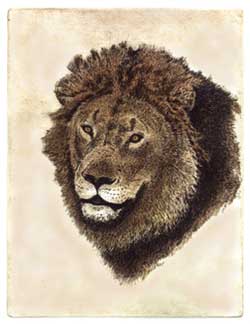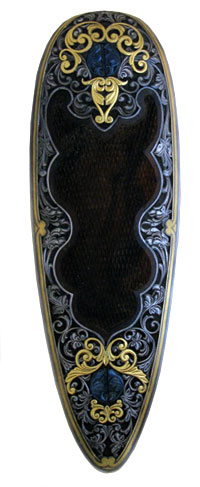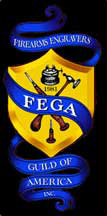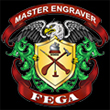| beginning: 4 questions |
Hi,
I am very interested in learning to engrave, and particularly the "bullino" style whereby I could accomplish detailed portraits. However, I am a student on a budget.
First question: in his book, Meeks details building one's own engraver's ball. Can this be done in a college machine shop (as of yet, I have no machining experience), and do you recommend trying this as a way to save money? I understand that balls aren't cheap. Also, if I make my own it will lack the adjustable braking of a commercial magnablock, for example; do you find this a vital function in a ball vise, or do you rarely use it and so making my own without it is no handicap?
Second: I have heard various comments on how tools like the gravermax or lindsay's pneumatic engraver have greatly improved the quality of one's work, to such effect that it is almost discouraging to start out without one. As I wish to accomplish engraving on a very small scale, is this a necessity? If so, will the cheaper "system 3" suffice? Or, are these tools most useful on hardened steels and other tough metals to cut by hand, and while I'm just practicing anyway, I could easily cut mild steel or aluminum or something as a practice piece without resorting to a powered pneumatic handpiece?
Third question: what gravers do I want to start out with? There seems to be a great deal of variety. I will, too, purchase FEGA's dvd on bullino engraving, which may give some ideas as well; though I'm almost equally interested in traditional scrollwork as well.
Fourth Question: Will 10X optivisors suffice, or do I want to use a microscope, and if so, how much clearance and magnifications should I look for and will a college lab probably lend me use of one during odd hours when it's not being used for a class?
thanks for your advice!
-Bernard Arnest
Bernard Arnest
8/4/2005 1:22:44 AM

![]()
![]()
![]()
|
Bernard,
Here's my personal suggested answers to your questions:
1. Since you have no machine shop experience,making your own vise isn't a beginners project in any machine shop. If you plan on having one of your "buddies" make one for you in their spare time (whatever the heck that is), you might be waiting a lot longer than it would take to save your money and buy one off of GRS, NgraveR,Ebay,or wherever.
2.This answer is Yes and No.Some of the best engravers in the world do not use pneumatic tools. However, some of the best engravers in the world do. Most of the engravers I know, including myself, do use them.(I have no experience with the System 3, but I'm to believe it is better suited for the jewelry trade----I could be wrong on that one.)
3.Most folks start out with either the square graver, or the onglette.
4.A 10X Optivisor will work nicely.
Now here's a suggestion I'd like for you to consider before you go out and purchase equipment:
Contact anyone at GRS, (www.grstools.com)enroll yourself in a beginners(or Basic) engravers class.
I guarantee it'll be the best money you'll ever spend! A professional engraver will actually teach you "Hands On".
At the GRS facility, you'll play with the very same tools a lot of the professionals use......and I believe that if you want to get the results the pros get, your chances are better if you use the stuff they are using.
All the best to you.
Brian
Brian Powley
8/4/2005 10:31:26 PM

![]()
![]()
![]()
|
For many years I have been using a 10X optivisor for my engraving. I also now have a microscope due to having back problems. While the microscope does have a definate advantage for magnification..I still prefer the optivisor most of the time. I like the freedom of movement it allows me and you don't always need the high mag of the microscope. I like seeing more area at times and the hi mag is over kill. For thos people who have seen and admire my banknote scenes, they find it hard to believe I do this with my optivisor. Remember that most of your clients look at your work with a naked eye...There are more important factors then miniscule detailing. These are learned with much practice and an understanding of some fine art concepts.
So go with the optivisor for starters and you can always upgrade to a scope if you feel you need one.
DEFINATELY TAKE SOME COURSES
Martin Rabeno
8/5/2005 9:23:54 AM

![]()
![]()
![]()
|
I agree with what Brian and Martin said, also:
Response to Question 2:
A pneumatic handpiece is the only way to go for scrollwork, I believe. For bulino work, however, a simple handgraver is about all I ever use. You can cut mild steel, aluminum, copper easily enough with a handgraver. There are times, even when doing detailed scenes, when a power graver may be handy, but it is not an absolute must. I have been using the GRS handgraver with quick-change gravers and am pleased with it. Any would work though.
Question 3:
I use square gravers for 98% of my work.
One thing to remember is you will need to sharpen the gravers often and good equipment to do so is important.
Question 4:
The optivisor will get you started well. That was all I used for years. When you can get one, a microscope is wonderful. I wouldn't want to try and do much work without one anymore - even if for nothing more than to see if the graver is sharp.
Bill Gamradt
8/6/2005 9:44:35 AM

![]()
![]()
![]()
|
Hi,
Thanks for the advice!
Does this seem like a sound plan:
-still try to make my own graver's ball (I'm stubborn)
-purchase bulino dvd from fega (maybe one other general engraving dvd?)
-purchase book on pen&ink drawing
-purchase good sharpening tool?
-perhaps purchase more gravers; try to get ones compatible with both GRS' interchangeable handles AND a future power graver so I won't need to buy new ones.
-save up for power graver for x-mas; also by then will know if I am serious enough for the investment. I think I am, but half a year of practice will confirm yes or no.
-save for microscope next; although will also see if a lab has one
Quick question: I bought the crocker graver sharpener from rio grande, and have two difficulties with it. It has no angle index, so it's hard to duplicate angles and I eyeball whether or not it's square. Also, at the advice of a couple people, I cut my gravers shorter such that one's index finger is just behind the bevel instead of 1/2" behind. However, now very little of the end of the graver comes through the crocker's clamp and the jig, not the graver edge, rests on my sharpening stone unless I use just the 1/4" of the edge. What do you recommend? Finally, at least for woodworking I've been using 400-1200 silicon carbide sandpaper for sharpening; is this good for gravers, too?
Quicker question: how come a pneumatic handpiece is necessary for scrolls but not for bulino? I had always just assumed that bulino required very fine, precisely spaced lines and if anything needed the control of a power tool it would...? Or, is it the tight curves of scrollwork? Btw, will a chaser's hammer get me started on scrolls until I've saved the money?
thanks!
-Bernard
Bernard Arnest
8/6/2005 5:52:36 PM

![]()
![]()
![]()
|
Don't get cheap on yourself with the engravers block. That will be the most durable, useful tool you will use. If it doesn't operate smoothy and hold your work securely, your work will always look like a hack job. Don't handicap yourself before you even begin.
Martin Rabeno
8/6/2005 7:28:50 PM

![]()
![]()
![]()
|
Pneumatic handpiece for scrolls?
For me, and my work, I usually cut the scrolls much deeper than the cuts used in wildlife, or scenes. This is in general, there are always exceptions. In scroll I am often after a different look than in a scene. Scroll can depend on reflected light for adding a 'dimensional' look to the work. Scenes can be similar to a pen and ink drawing - which uses only lines to define itself - not depth, or reflected light. The dark area of a scene, in metal, is basically the absence of reflected light.
The picture below is a print made from a copper plate I engraved entirely with a hand graver, no engravers vise, no microscope, occasional use of an optivisor.
Bill Gamradt
8/6/2005 10:53:08 PM

![]()
![]()
![]()
|
Hi,
Thanks for the advice!
And wow! What sort of hand engraver(s) did you use, what are the actual dimensions, and how did you hold the piece? I've heard of using a drill press vise fixed to a wooden plate that rotates on a simple dowl, would this work?
Although of coursefirst, before presuming that getting the same size/profile gravers you used will mean that my work will magically turn out as well, I'll follow some other sound advice that "your engraving is only as good as your drawing" and practice with pen and ink for a good while before picking up the graver... :-)
thanks for the advice!
-Bernard
Btw, which are the best dvds in FEGA's collection, or are some of the ones offered in Rio Grande and/or GRS also quite good...?
Bernard Arnest
8/6/2005 11:21:33 PM

![]()
![]()
![]()
|
The plate for the lion print is 6" x 8". Square graver only. The plate was just set on my bench. On some other plates I have mounted them on a piece of wood and then held them in the engraving block. As Marty said above, a good engraving block is quite important. Outside of some of the large, rather thick engraving copper plates virtually everything I engrave is held in a large, heavy engravers block and I can't imagine working without it.
Couldn't say about the drill press idea. Maybe others know.
Bill Gamradt
8/7/2005 1:01:16 AM

![]()
![]()
![]()
|
I can tell you about the drill press vise idea as I made the set up that you described. First, because only one of the jaws move on this type of vise it proves to be a challenge when trying to center your work to rotate in the middle of the rotation of the vise. Second, If the object that you place in the vise has any size at all then the vise screw is sticking out farther than is desired because when you rotate the vise the screw always seems to hit on something or get caught in your shirt. Not exactly a smooth operation and your engraving will suffer along with your patience. There is a reason that the engravers ball is so popular among engravers and that’s because it works well while substitutes do not.
If you are not sure if you want to engrave and are not sure what equipment to use then I would highly recommend that you enroll in one of GRS's beginners class. There you get to work with all types of equipment and get instruction from a professional engraver. By spending money on the class you just might save yourself the cost of investing in something that you decide you don't want to do, and if you decide that you do like it then the class will greatly increase your knowledge of engraving.
Anyway these are my thoughts I hope they may help you
Mike
Mike Bissell
8/7/2005 9:37:41 PM

![]()
![]()
![]()
|
Just to clarify something here, Optivisor does not make a 10X anything. I think the maximum power you can get from Optivisor with the optional loupe is 5X. Optivisor makes different lenses, labeled 1, 3, 5, 7 and 10 with various increasing power amounts. A #10 optivisor lens is 3.5 X . In comparison, microscope setups, in particular the Meiji setup as sold by GRS, has a power range of 3.5X -22X, so a #10 opitivisor and the scope are the same power. I used a #10 optivsor for years before switching to scope, and like Marty I did some real fine work with it. Although I will say the microscope is much easier physically on the back, shoulder and wrists than the optivisor because of your ability to sit in a more ergonomic working position. Also I think there is a huge advantage of the scope in being able to look straight down at the work, allowing you to instantly see a deviation from a straight line, whereas with the optivisor, your are looking at an angled sideways view of your graver making the cut. Nothing that you can’t get used to and do fine work with, its just that it is easier and better with the scope. And having that ability to zoom beyond 3.5X at the flip of a wrist is a NICE option.
Scott Pilkington
8/9/2005 10:24:52 AM

![]()
![]()
![]()
|
| Respond |
Back to Forum
|


|






